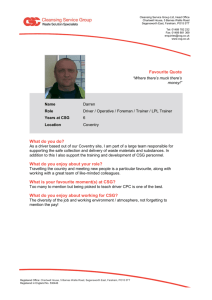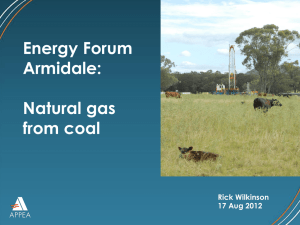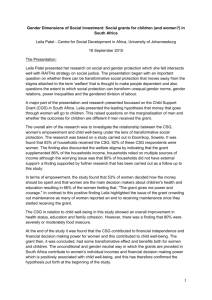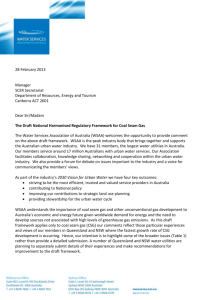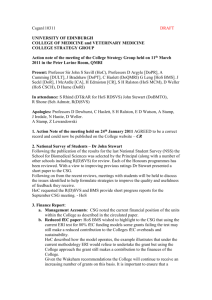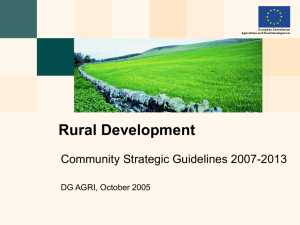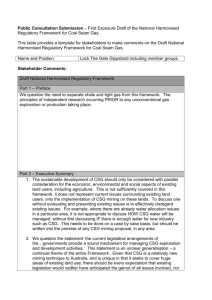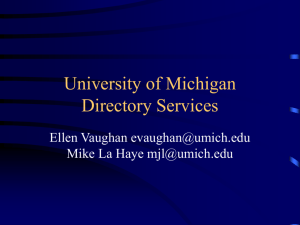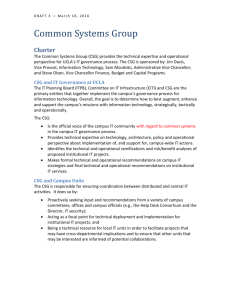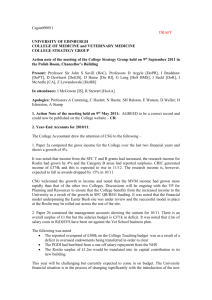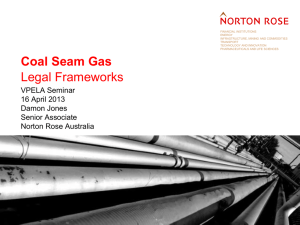Arrow Company Powerpoint
advertisement
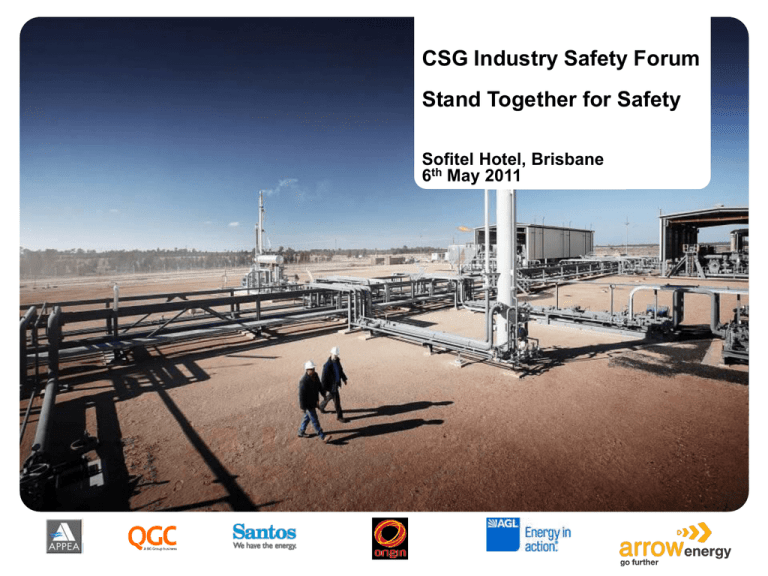
CSG Industry Safety Forum Stand Together for Safety Sofitel Hotel, Brisbane 6th May 2011 FIRE AND EVACUATION PROCEDURES 1. Raise the alarm by activating manual call point or dialling ‘2000’ 2. Fire alarm is a series of ‘beeps’ 3. Evacuation alarm is a series of ‘woop’ tones 4. Evacuate via nearest fire exit and follow staff directions 5. Muster area is in Railway Plaza DO NOT USE LIFTS 2 AGENDA Time Topic 8.45am Opening Address - The Safety Challenges Ahead for the CSG Industry Andrew Faulkner, Arrow Energy CEO 9.05am 9.25am 9.45am The Safety Challenges Ahead – Downstream Perspective Mark Macfarlane, Santos CEO GLNG Operations The Importance of Leadership during Site Visits Paul Zealand, Origin Executive General Manager – Oil and Gas Interactive Panel Discussion – Working Together and Closing the Gaps Ensign, Easternwell, Origin, Santos, QGC, DEEDI 10.45am 11.15am 11.45am 12.05pm 12.50pm 1.05pm 2.35pm 2.45pm Morning Tea APPEA Safety Guidelines Fatigue Management: Dr Kirsty McCulloch, Santos Vehicle Safety: Tim Coltzau, Origin Energy A Word from the Regulator – Stephen Matheson, Chief Inspector, Petroleum & Gas, DEEDI Lunch The CSG Industry Aero Medical Initiative – Stephen Pearson, QGC GM HSE Contractor Case Studies – Challenges + Solutions (FK Gardner; Leightons; Enerflex; Weatherford; Clough Seam Gas) Closing Remarks – Andrew Faulkner Afternoon Tea The CSG Industry – Working Together To Address our Safety Challenges Andrew Faulkner, CEO – Arrow Energy Safety moment The Golden Gate Bridge The roadway is 220 feet above the water which means that a fall from the roadway would almost invariably result in death. At the time of construction (1933-1938) it was expected that on a construction of this type, one person would die for every $1 million spent. With a cost of $37 million this obviously meant the expectation was for 37 people to die building this bridge. For the project manager Joseph B. Strauss, this was not acceptable so he decided to achieve unheard of performance, distinguish himself from his contemporaries, find a new “point of view” and care for his workers What Happened Two major changes were instigated:– He made everyone wear a hard hat. That seems like nothing much now but at the time no hard hats had been used on a site that was not below ground. – He installed safety nets to catch any falling workers. Now where did the nets come from if no-one had ever used them before? The circus. In the end 11 did die, (all towards the end of construction) 10 in one fall when a scaffold collapsed and the net could not hold the weight. But 19 were saved by the nets. These 19 formed the “Halfway to Hell” club. If he had done nothing, 30 would have died from falls and his project would still have been judged as successful – according to the standards of the day. So are we prepared to be judged as ‘successful’ by today’s standards… or do we CHOOSE to make a difference and be recognised in the future for our HSE excellence? The Challenges for Arrow Energy • • 7 The Arrow organisation has made good progress over the last 12 months… BUT! 4 high potential incidents in 2011 Not top quartile Lag indicator Ignores asset integrity Our HSE focus in 2011 is around: A. Developing Arrow Capabilities 1. Processes & Systems 2. People & Skills 3. Culture B. Our main HSE risk exposures 1. Vehicle safety 2. Working with Contractors Focus on the Main Risk Exposures 8 A Cumulative View of the Industry (2011 – 2017) 4 Major CSG to LNG Projects 20,000 workforce (at peak) 4,000+ wells to be drilled each year 2,500km of large diameter HP pipeline & many 1,000’s of km of gathering pipelines 50+ gathering / compressor stations 8 circa 4 mtpa LNG trains 10 - 20 mln vehicle kilometers p.a. Numerous large equipment journeys (road / rail / sea) Historical precedence would suggest between 0 - 20 fatalities across the 4 projects. Typically: Road transport Working at heights Confined space entry 9 Safety – The Challenge is Enormous and Affects Us All • • • • • • • • 10 Competition for experienced safety personnel Competition for technical / supervisory personnel with good safety competencies Competition for contractors – not all with good safety competency and attitude Many new people to industry – safety training & culture CSG Operating companies will demand higher safety standards Regulatory regime will continue to become stricter Community expectations for industry safety will increase – especially with community interface (eg. transport, emissions) A number of serious safety incidents, especially if affecting the community, will affect EVERYONE in the industry. What We Must Do Better • • • • • We must acknowledge the challenges and exposure We must all take responsibility Understand where your risks lie and focus accordingly Work cooperatively on safety improvement programmes – safety is not a competitive edge APPEA CSG Industry Safety Guidelines – common approach to key risks Work cooperatively with regulators on key industry-wide improvement areas CSG Operating companies to offer safety tools, training, programmes to contractors to assist in their improvement Do not mix safety and productivity messages • There is no quick fix. • • • 11 CSG Industry Safety Forum Sofitel Hotel, Brisbane 6th May 2011 CSG Industry Safety Forum Panel Discussion Working Together Panel Members Jim Knudsen QGC John Bushell Ensign Energy Janet Hann Origin Stephen Matheson DEEDI Warren Wilmington Easternwell Rick Wilkinson Santos 14
